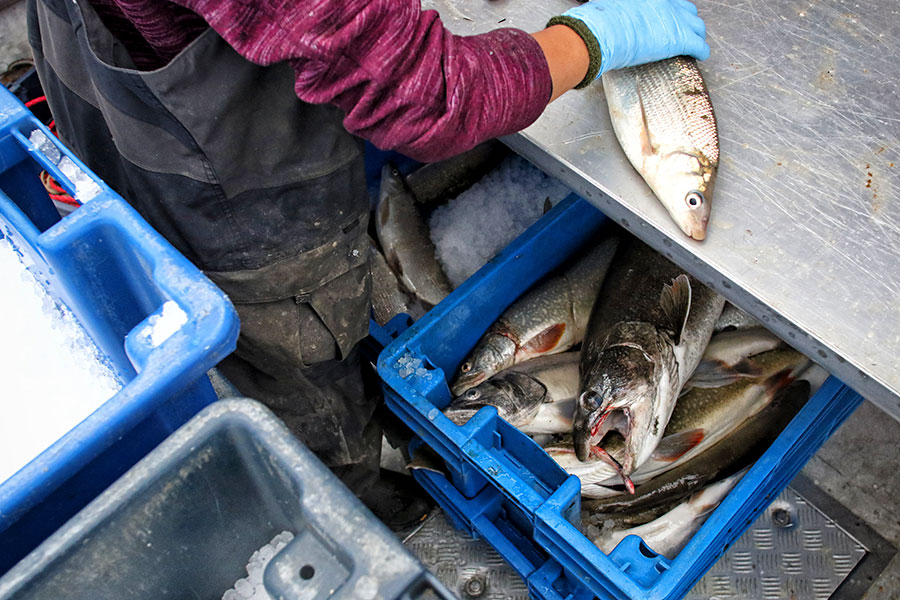As Bull Trout Spawning Numbers Decline in the Swan, FWP Proposes Lake Trout Removal
Agency officials will ask the Fish and Wildlife Commission for approval of a gillnetting program to suppress the invasive species and conserve the native trout
By Tristan Scott
State fisheries managers next month will ask the Montana Fish and Wildlife Commission for permission to resume gillnetting for invasive lake trout on Swan Lake after the number of bull trout spawning nests in the drainage fell dramatically last year.
Although northwest Montana and Glacier National Park have historically remained one of the best strongholds for native bull trout in the state, the region has seen its wild populations of the threatened species decimated by the explosion of invasive lake trout. Fisheries managers also blame reduced stream flows and warming water temperatures as among the most critical stressors imperiling the species’ long-term survival, which depends on cold, clear and connected aquatic habitats.
As required by the Montana Environmental Policy Act (MEPA), FWP will complete scoping of the proposed project before any management action.

If approved, fisheries managers would ramp up their monitoring efforts of lake trout in Swan Lake before implementing the gillnetting strategy in 2025, resuming an invasive species suppression campaign that has proven effective in the past.
Between 2009 and 2016, FWP and its partners conducted an eight-year experimental lake trout removal project on Swan Lake to determine whether suppression tactics such as gillnetting are effective at reducing lake trout abundance and improving native bull trout and kokanee salmon populations. However, lake trout populations rebounded once the project was concluded on Swan Lake, while the abundance of native species resumed a negative trajectory.
“Since 2016, Swan Lake bull trout and kokanee abundances have declined while lake trout has increased considerably,” according to an agenda item submitted by Montana Fish, Wildlife and Parks (FWP) in advance of the Feb. 16 commission meeting. “Bull trout redd (spawning nests) counts in 2023 revealed the lowest number on record.”
Additional lake trout population assessment and modeling since 2016 has shown that increased gillnetting efforts to remove lake trout could positively influence bull trout abundance, according to FWP.
“With no action bull trout numbers are expected to continue to decline while lake trout increase,” according to the agency’s proposal to commissioners.
According to FWP’s monitoring data, which spans more than 40 years, declining redd numbers were documented at 48% of FWP’s monitoring sites last fall. They were shown to be increasing in 12% of the sites and registered as stable in 40%.
Generally, monitoring sites within “quality and connected habitats,” such as the South Fork Flathead River and Hungry Horse Reservoir, have seen relatively stable or slightly increasing population sizes, according to FWP. Many smaller populations in habitats that are lower quality or not connected with other populations are mostly stable or declining, the agency stated.
Last spring, FWP and the U.S. Fish and Wildlife Service (FWS) announced the formation of an interagency working group to address bull trout issues and to coordinate recovery efforts this winter. The group includes members from federal and state agencies, tribes, researchers and non-governmental organizations. Input from the group will help inform a statewide conservation strategy being developed by FWP and partners.
“Bull trout need clear, cold water and complex, connected habitat,” Eric Roberts, FWP’s fisheries management bureau chief, said. “We’ve done a lot of work to provide for these things in bull trout streams and we need to look at doing more.”
Lake trout populations exploded after the state introduced mysis shrimp into the upper Flathead Drainage in 1968, and appeared in Flathead Lake in 1981. The increase in non-native lake trout led to the collapse of the kokanee salmon fishery and steep declines in native fish, including bull and cutthroat trout. It’s an oft-cited example by local fisheries managers and conservationists to illustrate how invasive species erode biodiversity and lead to steep economic losses, including about $120 billion in annual damages in the U.S. alone.
For the past four decades, state biologists annually travel more than 200 miles of streams and collect information from spawning areas, counting the number of spawning nests, called redds. Redd counts are indicative of the abundance levels of spawning adult bull trout each year and are used to assess status and trends in bull trout populations in northwest Montana.
While FWP biologists say the decline of bull trout redds is mostly due to warming water and altered stream flows, loss of habitat, and predation by and competition with non-native fish, such as northern pike and lake trout, hybridization with brook trout can also impact bull trout. Other contributing factors are reduced fish passage and habitat degradation.
“Bull trout recovery is going to require all of us to work together,” said Dan Brewer, of the FWS in Montana, in announcing the working group’s formation. “We appreciate the leadership of FWP and all those involved to help recover this species.”